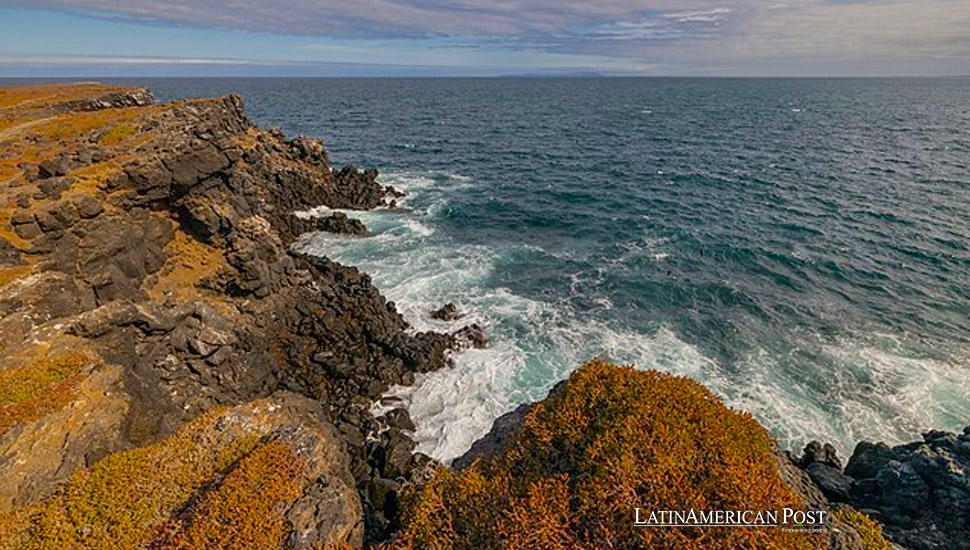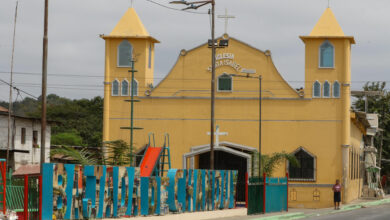Ecuador’s Galapagos Islands Facing Climate Change and Invasive Species

The collapse of Darwin’s Arch in 2021 highlighted the fragility of the Galapagos Islands. As climate change and invasive species threaten this unique ecosystem, scientists are working to understand and mitigate the impacts on its diverse wildlife.
Warm morning light reflects from the remains of a natural rock arch near Darwin Island, one of the most remote islands in the Galapagos. In clear, deep blue water, thousands of creatures—fish, hammerhead sharks, mDarwin’suanas, and Darwin’suanas—move in search of food.
The 2021 collapse of Darwin’s Arch, named for the famed British naturalist who developed the theory of evolution, came from natural erosion. But its demise underscored the fragility of a far-flung archipelago that’s coming under increased pressure from climate change and invasive species.
Warming oceans affect the food sources of many of the seagoing animals in the Galapagos. Marine iguanas — one of many species that are endemic, or unique, to the Galapagos — have a more challenging time finding the red and green algae they prefer. Sea turtles struggle to nest in warmer temperatures. Raising young gets harder as water warms and fewer nutrients are available.
Impact of Warming Oceans on Galapagos Wildlife
The Galapagos Islands and their many creatures have always been sensitive to changes in ocean temperatures. However, the significant warming caused by climate change in recent years has put pressure on many species in the remote islands off the coast of Ecuador.
While the Galapagos is known for lacking many species, their numbers aren’t unlimited. The archipelago itself is located where major ocean currents converge—cool from the south, warm from the north, and cold upwelling current from the west. Then there’s El Nino, the periodic and natural Pacific Ocean warming that affects weather worldwide.
While temperatures vary depending on the season and other naturally occurring climate events, ocean temperatures have been rising because of human-caused climate change as oceans absorb the vast majority of excess heat in the atmosphere. The ocean experienced its warmest decade in at leastocean’s00s in the last ten years, and 2023 was its warmest year on record.
Early June brings winter in the Southern Hemisphere, and the Cromwell current brings whale sharks, hammerheads, and massive sunfish to the surface. It also provides nutrients for penguins, marine iguanas, and sea lions in search of food. As more animals become known this season, scientists are tracking how they fared in the warming of the past year’s El Nino.
El Nino, a periodic and natural Pacific Ocean warming that affects weather worldwide, can cause food shortages for some species, such as marine iguanas and sea turtles, as the warmer ocean means dwindling food sources. Scientists observing the species have noted a significant decline in population numbers during El Nino events.
Marine iguanas swim like snakes through the water from rock to rock as waves crash against the shore of Fernandina Island. They latch themselves onto the undersea rocks to feed on algae growing there, while sea lions spin around them like puppies looking for someone to play with.
Iguanas were among the most affected species by El Niño last year and are still recovering. While rising ocean temperatures threaten aquatic or seagoing life, on land, there’s a different problem. Feral animals—cats, dogs, pigs, goats, and cattle, none of them native—are threatening the unique species of the islands.
After the COVID-19 pandemic, many people abandoned their dogs and cats to keep them company. If you don’t care for them, they become a problem, and now it ia a shame to see dogs everywhere. We have a big problem right now. I don’t know what we’re going to do.
The Threat of Invasive Species
The non-native animals are a particular threat to the giant tortoises closely associated with the Galapagos. The tortoises declined dramatically in the 19th century due to hunting and poaching, and authorities have worked to protect them from humans. It’s been illegal to kill a giant tortoise since 1933.
In one night, a feral pig can destroy all nesting sites in an area. Park rangers try to visit areas with nesting sites once a day and kill pigs when they find them. But the pigs are elusive.
Feral cats feed on marine iguana hatchings, and both pigs and cats compete with tortoises for food worldwide.
If invasive species and warming oceans weren’t enough, plastic is a widespread problem in the world’s oceans. One recent study reported microplastics in the bellies of Galapagos penguins.
There are no animals in the Galapagos that do not have microplastics in their food. The islands, renowned for their unique biodiversity and significant role in the evolution study, are now a stark reminder of the global environmental crisis. This crisis is not just local, but a global issue that requires collective action.
As the Galapagos faces these challenges, conservationists are working tirelessly to protect this vital ecosystem. Their efforts range from combating invasive species to addressing the impacts of climate change. The challenges are immense, but the dedication and perseverance of these conservationists in preserving the Galapagos’ natural heritage are truly inspiring.
Also read: New Species of Glass Frog Discovered in Ecuador
From combating invasive species to addressing the impacts of climate change, the work being done in the Galapagos serves as a critical model for conservation efforts worldwide. The fragile balance of life on these islands poignantly illustrates the broader environmental challenges facing our planet, but also offers hope and inspiration for the future.




